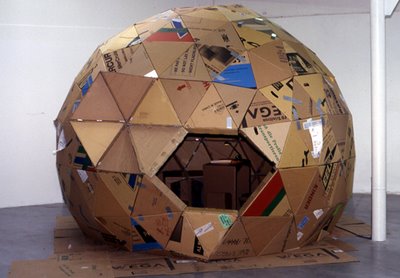
You wanna know the difference between our hippies and the hippies in the 70's? They both lived in lofts on the Lower East Side; they both went on about the environment, and they both built geodesic domes out of cardboard.
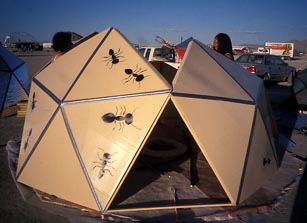
But 21st century hippies took nine whole pages of detailed building instructions to totally confuse me disabuse me of the idea of whipping up a cool geodesic playdome for the kid using refrigerator boxes and Mr. McGroovy's Cardboard Rivets. 1972 hippies did that in five sentences.
Don't get me wrong. I think building a kid-sized dome playhouse would be just about the coolest thing going, and cardboard seems like the most logical, economical, and ecological material to use. But I've spent a lot of time researching domebuilding since Andy posted that link to artist Oscar Tuazon's 2002 cardboard dome sculpture last week [top], and I gotta say, building a dome seems like a time-consuming pain in the ass.
If you're still interested, though, here's what I've found. There are some vintage and contemporary resources to help you out.
Monkeyc's cardboard dome howto
First off, if time is no object, and you want to build a kick-ass cardboard dome with a design that's been stress-tested at multiple Burning Mans, then stop right here and head over to Jon Smith's extensive how-to instructions at monkeyc.org. Jon has built multiple domes for multiple trips to Black Rock City, and if you follow his instructions, I don't doubt that your dome could withstand wind, sand and dust storms, crayons, even the occasional sprinkler hit, with no problem.
Desert Domes' dome calculator
The other must-visit online home for DIY dome is another Burner, Tara Landry's Desert Domes, which has a tantalizingly easy-to-play-with dome calculator, that spits out the parts list and dimensions for domes of many shapes and frequencies.
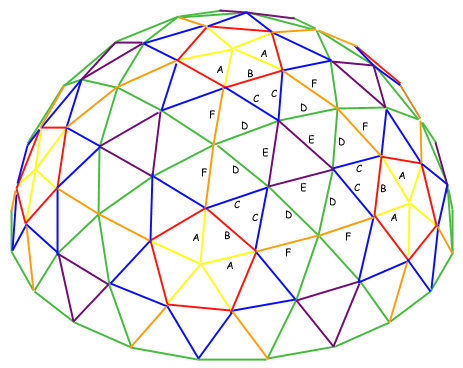
Only there's a catch: the Desert Domes calculator outputs the number of and length of struts, not panels. To get the panel dimensions requires matching up and tallying each ABB BDE etc. into corresponding triangles. Then you make the templates for those triangles, adding connector tabs along each side.
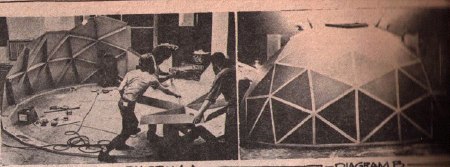
Domebook2 & CHARAS
I thought I'd go old-school back when everyone and their communemate was learning how to make domes at Buckminster Fuller's sainted knee. So I broke out my tattered copy of Domebook2, a classic 1971 treatise of the domebuilder's art [though my copy is from the 1974 3rd. ed.], which combines primers on geodesic geometry, pre-computer-era calculation tables, and technical accounts of domeraisings from all over the world and California.
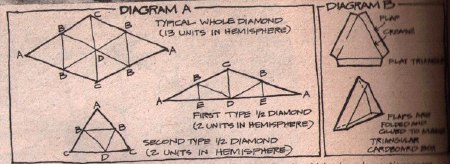
Toward the back, there was a page of tips for working with cardboard, even, and then above it, was the dome success story of CHARAS, "a group of young street people from New York's Lower East Side," whose purpose is to "explore the possibilities of low cost housing." Here's what they learned to do from Bucky Fuller's assistant, Michael Ben-Eli [scans of both segments are in the daddytypes flickr pool.]:
One of our models was a 5' diameter dome which was made from corrugated board scraps we found in a loft that we have. [emphasis added for real estate nostalgia. -ed.] It was a 4-frequency 1/2 sphere based on the triacontehedron [sic]. It was made up of two different triangles that were assembled into 13 whole diamonds and four half diamonds as in diagram A. These sections were then assembled into the dome. We used contact cement and staples to connect the flaps.Sounds awesome! I'll just swap out the cement and staples for some handy dandy Cardboard Rivets and--oh wait, I can't figure out how this five-sentence explanation maps onto the nigh-impenetrable tables of chords and angles so that I can calculate the dimensions of these two triangles.
It seems that one triangle, ABE, is half the other, ABB. Does that mean that all the other triangles are the same size? Or are there actually three triangles, ABB, BCD, and ABE=ABB/2?
Landry's dome calculator is set up for icosahedron domes, not triacontahedrons, and any configuring attempt I make results in various sizes of slightly different triangles, not three, and definitely not two.
So far, about all I can figure out is that it'd take about 332 of Mr McGroovy's Cardboard Rivets if you leave off a couple of triangles for a door and a window. That's seven boxes, bigger than two Big Daddy sets. The rivets alone will set you back $53.
With that kind of volume, though, if this dome idea ever takes off, the next three McGroovy kids will probably all be named Buckminster Greg.
Anyone who knows domes know what to do now?
See scans of cardboard doming from Domebook2 in the daddytypes flickr pool [flickr]

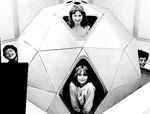
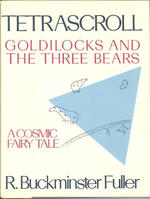
Try making models out of cardboard and plasticine? I find figuring out the math beforehand is often more frustrating than building a model and then making the math fit your model... :D
[math is hard! let's go chopping! -ed.]
It's times like this when I bet you wish you lived with a rocket scientist or somethi... oh, wait, right.
[maybe she's trying to tell me something with all her "enough with the domes already, crazyman!" eye rolls, but I don't know what it is. -ed.]
Log onto http://www.domebook.com to see other cardboard domes. The book shows how to construct nine different domes in any size you want. You can also download paper models of 2 frequency and 3 frequency icosa domes. A photo of the 2 frequency icosa dome is on the index page of the site. The plans for those two domes are in the book.
This is great stuff!!
Any idea where I can find an archive of Jon's dome page? Headed home and a baby dome for our camp sounds sick.
RIP:
monkeyc.org